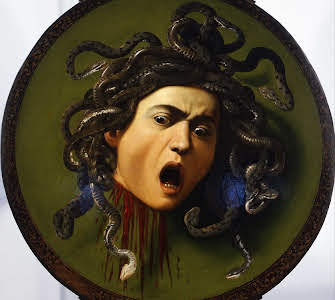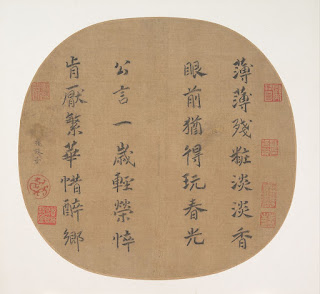My Renaissance Piece
I chose the Medusa painting by Caravaggio Merisi, because it really captured my attention, mostly due to the message it served. Medusa was often used to represent military power during this period of time. It can be connected to Humanism in a way too because it can be tied to morals and philosophical inquires. I really felt a connection to it, because I look at Medusa in another way. She overcame a lot of grief, but she still emitted power and showed resilience. In 1598 Cardinal Francesco Maria del Monte gave this painted shield to Grand Duke Ferdinando I. It was put in the Armory of the Uffizi without any attribution; in 1631 it was registered as a work by Caravaggio and was displayed as part of a suit of Persian Armor worn by a mannequin seated on a wooden horse. The way artist used different hues with the use of darker colors, such as dark greens, browns, and blues for the background. I also enjoyed that the artist used the value to bring out more darkness, it really made her face the main point; which gave such real emotions of fear and intensity. Speaking of intensity, the mixture of both brightness and duller colors mix well. Overall, the photo brought up feelings of resilience, and fear to show how it can influence people in battle. Again, I find myself being drawn to darker pieces of art, I felt more of a connection to this piece because of the emotions it brought out. I would own a copy of this if I could, and I can relate to it fully.
Merisi, C., 1598. Medusa - Caravaggio Merisi - Google Arts & Culture. [online] Google Arts & Culture. Available at: <https://artsandculture.google.com/asset/medusa-caravaggio-merisi/FAFPqU12CekL8Q> [Accessed 1 October 2022].



Hi Autumn, I absolutely agree with your analysis of the elements of the piece. The utilization of value and color truly gives the subject a menacing feel. There are such strong emotions behind this piece, it is astounding how much a two-dimensional image can impact your entire mood. I would have loved to see more of an analysis on how the piece corresponds with the movement of humanism.
ReplyDeleteThe story behind how she became such a memorable villain throughout history is quite fascinating. She was punished by Athena for her sinister relationship with the God of the Sea, Poseidon. She was beheaded, transformed into an ugly woman, and given snakes for hair. Wow, what an intense punishment!
A great contribution to the discussion! I don't really like this piece very much because the colors are kind of dull and muted. Humanism is shown through facial expressions and facial features. Death is also portrayed and highlights mortality. I do not like that the image shows the head-mounted, although it makes the viewer feel like she is reduced to being an animal which is a powerful message. Thanks for sharing!
ReplyDelete